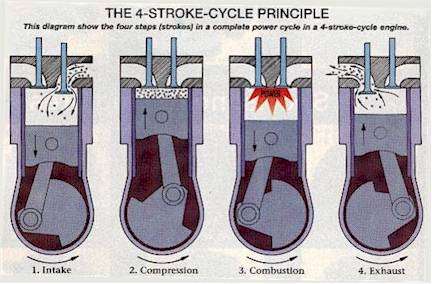
STINT AS GASOLINE
During this time, Jack and Jill undergo a position change of several thousand kilometers, and this change is accompanied by periods of positive and negative acceleration, and constant and non-constant velocity, as they are moved north, acted upon by the (usually forward) motion of the truck, and as always by gravitational acceleration. Fluid turbulence also acts on the gasoline, despite the baffles built into the tanks, but this is a far more complex issue than we can deal with here, other than to say that it is caused by the acceleration of the truck (not only forward, but around curves and over bumps in the road).
Eventually Jack and Jill, with billions of atoms similar to them in similar molecules, are deposited in an underground tank at a gas station. Before very long, they are pumped up into the gas tank of a car, for final consumption.
Jack and Jill, while involved in the general motion of the car as it moves, eventually experience a forward acceleration from the tank into the engine when the car’s fuel pump engages them. Soon they are vaporized and sprayed into the engine, where the molecules of which they are part combust and release energy into the car’s engine. This combustion creates an increase in pressure as the potential energy bound up the molecules’ chemical bonds is transformed into kinetic energy which forces the piston’s downward. The energy first imparted to the molecules as pressure in the oil field, which was stored up in the chemical bonds, is now released to do work, as it is translated through the fluid actions in the car’s transmission into the wheels of the car.
The gasoline is broken down after combustion into very simple molecules. Jack and Jill become separate molecules of carbon dioxide, and are expelled into the atmosphere by the car’s exhaust system.